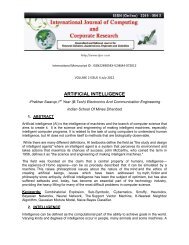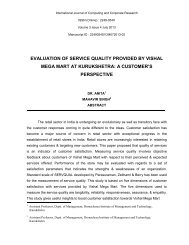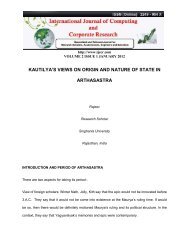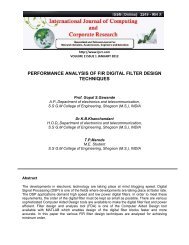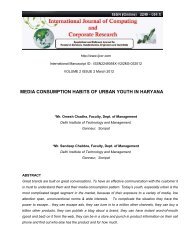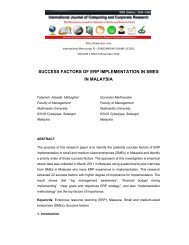ground potential rise in high voltage substations - Ijccr.com
ground potential rise in high voltage substations - Ijccr.com
ground potential rise in high voltage substations - Ijccr.com
You also want an ePaper? Increase the reach of your titles
YUMPU automatically turns print PDFs into web optimized ePapers that Google loves.
http://www.ijccr.<strong>com</strong><br />
International Manuscript ID : ISSN2249054X-V2I2M1-032012<br />
VOLUME 2 ISSUE 2 March 2012<br />
GROUND POTENTIAL RISE IN HIGH VOLTAGE SUBSTATIONS<br />
Dwarka Prasad 1 , Dr.H.C Sharma 2<br />
1 Research Scholar, Uttarakhand Technical University, Dehardun (Uttarakhand),India.<br />
1 Department of Electrical Eng<strong>in</strong>eer<strong>in</strong>g<br />
1 Laxmi Devi Institute of Eng<strong>in</strong>eer<strong>in</strong>g & Technology, Alwar, Rajasthan,India.<br />
2 Department of Electrical & Electronics Eng<strong>in</strong>eer<strong>in</strong>g<br />
2<br />
Vishveshwarya Institute of Eng<strong>in</strong>eer<strong>in</strong>g &Technology, Dadri,India.<br />
Abstract: Ground Potential Rise (GPR) is a concern <strong>in</strong> the design of substation <strong>ground</strong><strong>in</strong>g<br />
grid. This paper will present Ground Potential Rise (GPR) causes, effects, variations <strong>in</strong> the<br />
values GPR <strong>in</strong> <strong>high</strong> <strong>voltage</strong> <strong>substations</strong>. The purpose of this paper is provide knowledge<br />
about the GPR, substation <strong>ground</strong><strong>in</strong>g grid and step and touch <strong>potential</strong>s.<br />
Keywords: Ground Potential Rise (GPR), Ground<strong>in</strong>g, Resistivity, Step and Touch Potential<br />
I. INTRODUCTION<br />
High <strong>voltage</strong> <strong>substations</strong> are very important for the electric power system stability. Any<br />
malfunction can cause blackout. The blackout results <strong>in</strong> loss which will be crucial for
http://www.ijccr.<strong>com</strong><br />
International Manuscript ID : ISSN2249054X-V2I2M1-032012<br />
VOLUME 2 ISSUE 2 March 2012<br />
electricity generat<strong>in</strong>g <strong>com</strong>panies, boards and for ultimate consumer also. Where <strong>high</strong> and<br />
low <strong>voltage</strong> earth<strong>in</strong>g system exists <strong>in</strong> proximity, part of the GPR (Ground Potential Rise) from<br />
HV system is impressed on the LV system. High <strong>voltage</strong> <strong>substations</strong> are very often placed <strong>in</strong><br />
the open area. They consist of many <strong>high</strong> metallic <strong>com</strong>ponents such as overhead<br />
transmission towers, busbars, bridges etc. and are exposed to direct lightn<strong>in</strong>g strike.<br />
Malfunction of the electric system feed<strong>in</strong>g-po<strong>in</strong>ts can be catastrophic for national economy.<br />
It can cause electric power system break-up. Dur<strong>in</strong>g strike, <strong>ground</strong><strong>in</strong>g system will transfer<br />
light<strong>in</strong>g current to earth. Parameters of this system are chang<strong>in</strong>g dynamically dur<strong>in</strong>g the<br />
lightn<strong>in</strong>g current flow. This effect causes a <strong>ground</strong> <strong>potential</strong> <strong>rise</strong> (GPR) dur<strong>in</strong>g the lightn<strong>in</strong>g<br />
with respect to remote earth or other substation <strong>ground</strong><strong>in</strong>g system. When a large amount of<br />
energy is rapidly deposited <strong>in</strong> to the <strong>ground</strong> by a cloud-to–<strong>ground</strong> lightn<strong>in</strong>g strike or by an<br />
electrical fault on a utility power system, the <strong>ground</strong> <strong>potential</strong> at this junction po<strong>in</strong>t <strong>rise</strong>s to a<br />
<strong>high</strong>er level with respect to the more distant. Direct lightn<strong>in</strong>g strike to the earthed<br />
<strong>com</strong>ponents of HV substation can cause severe <strong>in</strong>terference problems <strong>in</strong> electronic<br />
equipment and systems.<br />
Electrical and electronic devices, as a part of <strong>high</strong> <strong>voltage</strong> <strong>substations</strong> are susceptible to<br />
disturbances or destruction by direct lightn<strong>in</strong>g strokes. A lightn<strong>in</strong>g discharge current can<br />
cause disturbances to 1-3km from strike centre, depend<strong>in</strong>g on impedance factors, soil<br />
structure and other variables. Lightn<strong>in</strong>g protection specialist should consider all situations <strong>in</strong><br />
over<strong>voltage</strong> analysis [1].<br />
The severity of the <strong>ground</strong> <strong>voltage</strong> <strong>rise</strong> and associated hazards are directly <strong>in</strong>fluenced by the<br />
effectiveness of the <strong>ground</strong><strong>in</strong>g grid. A key performance <strong>in</strong>dicator is the <strong>ground</strong><strong>in</strong>g system<br />
impedance. High overall impedance relates to a greater <strong>ground</strong> grid <strong>voltage</strong> <strong>rise</strong> and
http://www.ijccr.<strong>com</strong><br />
International Manuscript ID : ISSN2249054X-V2I2M1-032012<br />
VOLUME 2 ISSUE 2 March 2012<br />
subsequently <strong>high</strong>er touch and step <strong>voltage</strong>s. The effect of fault-produced <strong>ground</strong> <strong>potential</strong><br />
<strong>rise</strong> can directly result <strong>in</strong> mistak<strong>in</strong>g operation, damag<strong>in</strong>g of equipment or human safety<br />
[2].Ground grid is mostly done at the beg<strong>in</strong>n<strong>in</strong>g stage of substation design and, firstly, its<br />
design purpose is considered well for both human safety and equipment protection [3-5].<br />
II. PURPOSE OF GROUNDING SYSTEM<br />
The purpose of a <strong>ground</strong><strong>in</strong>g system at a substation <strong>in</strong>cludes the follow<strong>in</strong>g:<br />
1.To provide the <strong>ground</strong> connection for the <strong>ground</strong>ed neutral for transformers, reactors and<br />
capacitors.<br />
2.To provide the discharge path for lightn<strong>in</strong>g rods, surge arrestors, spark gaps and other<br />
similar devices.<br />
3.To ensure safety to operat<strong>in</strong>g personnel by limit<strong>in</strong>g <strong>potential</strong> differences that can exist <strong>in</strong> a<br />
substation.<br />
4.To provide a means of discharg<strong>in</strong>g and de- energiz<strong>in</strong>g equipment to proceed with<br />
ma<strong>in</strong>tenance on the equipment.<br />
5.To provide a sufficiently low resistance path to <strong>ground</strong> to m<strong>in</strong>imize <strong>rise</strong> <strong>in</strong> <strong>ground</strong> <strong>potential</strong><br />
with respect to remote <strong>ground</strong>. The substation <strong>ground</strong><strong>in</strong>g system is connected to every<br />
<strong>in</strong>dividual equipment, structure and <strong>in</strong>stallation <strong>in</strong> the substation so that it can provide the<br />
means by which <strong>ground</strong><strong>in</strong>g currents are conducted to remote areas.<br />
III. CAUSES OF GROUND POTENTIAL RISE<br />
Earth Potential Rise (EPR) also called Ground Potential Rise (GPR) occurs when a large<br />
current flows to earth through earth grid impedance. The <strong>potential</strong> relative to a distant po<strong>in</strong>t<br />
on the Earth is <strong>high</strong>est at the po<strong>in</strong>t where current enters the <strong>ground</strong>, and decl<strong>in</strong>es with<br />
distance from the source. Ground <strong>potential</strong> <strong>rise</strong> is a concern <strong>in</strong> the design of electrical<br />
substation because the <strong>high</strong> <strong>potential</strong> may be a hazard to people or equipment. The
http://www.ijccr.<strong>com</strong><br />
International Manuscript ID : ISSN2249054X-V2I2M1-032012<br />
VOLUME 2 ISSUE 2 March 2012<br />
<strong>potential</strong> gradient (drop of <strong>voltage</strong> with distance) may be so <strong>high</strong> that a person could be<br />
<strong>in</strong>jured due to the <strong>voltage</strong> developed between two feet, or between the <strong>ground</strong> on which the<br />
person is stand<strong>in</strong>g and a metal object. Any conduct<strong>in</strong>g object connected to the substation<br />
earth <strong>ground</strong>, such as telephone wires, rails, fences, or metallic pip<strong>in</strong>g, may also be<br />
energized at the <strong>ground</strong> <strong>potential</strong> <strong>in</strong> the substation. This transferred <strong>potential</strong> is a hazard to<br />
people and equipment outside the substation.<br />
Ground Potential Rise is caused by electrical substation, power plants or <strong>high</strong> <strong>voltage</strong><br />
transmission l<strong>in</strong>es or when lightn<strong>in</strong>g strikes, Ground Potential Rise occurs, which can<br />
damage equipment and <strong>in</strong>jure personnel work<strong>in</strong>g on the equipment unless proper isolation<br />
or protection is provided. The GPR produces a dangerous <strong>potential</strong> difference between the<br />
power station and a remote <strong>ground</strong> connection located at a telephone <strong>com</strong>pany control<br />
office, remote term<strong>in</strong>al, distant manufactur<strong>in</strong>g build<strong>in</strong>g or other sites. Tele<strong>com</strong>munication<br />
cable damage can occur if <strong>ground</strong><strong>in</strong>g takes place across the <strong>potential</strong> difference caused by a<br />
power fault or lightn<strong>in</strong>g strike.<br />
Short circuit current flows through the plant structure and equipment and <strong>in</strong> to the <strong>ground</strong><strong>in</strong>g<br />
electrode station .The resistance of Earth is f<strong>in</strong>ite, so current <strong>in</strong>jected <strong>in</strong> to the earth at the<br />
<strong>ground</strong><strong>in</strong>g electrode produces a <strong>potential</strong> a <strong>potential</strong> <strong>rise</strong> with respect to a distant reference<br />
po<strong>in</strong>t. The result<strong>in</strong>g <strong>potential</strong> <strong>rise</strong> can cause hazardous <strong>voltage</strong>, many hundreds of yards<br />
(meters) away from the actual fault location. Many factors determ<strong>in</strong>e the level of hazard<br />
,<strong>in</strong>clud<strong>in</strong>g: available fault current,, soil type, soil structure, temperature, underly<strong>in</strong>g rock<br />
layers, and clear<strong>in</strong>g time to <strong>in</strong>terrupt a fault.<br />
The <strong>ground</strong> <strong>potential</strong> <strong>rise</strong> (GPR) aris<strong>in</strong>g from real power system <strong>ground</strong> faults is also of<br />
particular importance to tele<strong>com</strong>munication <strong>com</strong>panies. If <strong>high</strong> enough, the <strong>rise</strong> <strong>in</strong> <strong>potential</strong>
http://www.ijccr.<strong>com</strong><br />
International Manuscript ID : ISSN2249054X-V2I2M1-032012<br />
VOLUME 2 ISSUE 2 March 2012<br />
of the <strong>ground</strong> can cause <strong>in</strong>sulation breakdown and other damage to nearby<br />
tele<strong>com</strong>munication cabl<strong>in</strong>g and equipment. In addition to this, the GPR can create hazards<br />
for technicians work<strong>in</strong>g on the affected circuits. The GPR traverse measurements can be<br />
used to gauge the severity of the GPR encountered dur<strong>in</strong>g a real power system <strong>ground</strong> fault.<br />
IV. STEP AND TOUCH POTENTIALS<br />
The flow of electric current through the human body is a source of danger. Standards def<strong>in</strong>e<br />
limits on body currents that can be caused by touch<strong>in</strong>g <strong>ground</strong><strong>in</strong>g structure under adverse<br />
conditions. Consequently, <strong>ground</strong><strong>in</strong>g system should be designed so that the possible electric<br />
body current <strong>in</strong> an operator or by stander should not exceed these limits.<br />
Abnormal operations <strong>in</strong>cludes on the level of the <strong>potential</strong> difference between earth po<strong>in</strong>ts<br />
and <strong>ground</strong>ed hazardous condition may be generated for human be<strong>in</strong>gs. This condition may<br />
result from two dist<strong>in</strong>ct possibilities [6-8].<br />
"Step <strong>potential</strong>" is the <strong>voltage</strong> between the feet of a person stand<strong>in</strong>g near an energized<br />
<strong>ground</strong>ed object. It is equal to the difference <strong>in</strong> <strong>voltage</strong>, given by the <strong>voltage</strong> distribution<br />
curve, between two po<strong>in</strong>ts at different distances from the "electrode". A person could be at<br />
risk of <strong>in</strong>jury dur<strong>in</strong>g a fault simply by stand<strong>in</strong>g near the <strong>ground</strong><strong>in</strong>g po<strong>in</strong>t.<br />
"Touch <strong>potential</strong>" is the <strong>voltage</strong> between the energized object and the feet of a person <strong>in</strong><br />
contact with the object. It is equal to the difference <strong>in</strong> <strong>voltage</strong> between the object and a po<strong>in</strong>t<br />
some distance away. The touch <strong>potential</strong> could be nearly the full <strong>voltage</strong> across the<br />
<strong>ground</strong>ed object if that object is <strong>ground</strong>ed at a po<strong>in</strong>t remote from the place where the person
http://www.ijccr.<strong>com</strong><br />
International Manuscript ID : ISSN2249054X-V2I2M1-032012<br />
VOLUME 2 ISSUE 2 March 2012<br />
is <strong>in</strong> contact with it. For example, a crane that was <strong>ground</strong>ed to the system neutral and that<br />
contacted an energized l<strong>in</strong>e would expose any person <strong>in</strong> contact with the crane or its<br />
un<strong>in</strong>sulated load l<strong>in</strong>e to a touch <strong>potential</strong> nearly equal to the full fault <strong>voltage</strong>.<br />
"Mesh <strong>potential</strong>" is a factor calculated when a grid of <strong>ground</strong><strong>in</strong>g conductors is <strong>in</strong>stalled.<br />
Mesh <strong>potential</strong> is the difference between the metallic object connected to the grid, and the<br />
<strong>potential</strong> of the soil with<strong>in</strong> the grid. It is significant because a person may be stand<strong>in</strong>g <strong>in</strong>side<br />
the grid at a po<strong>in</strong>t with a large <strong>potential</strong> relative to the grid itself.<br />
V. SAFETY<br />
Earth <strong>potential</strong> <strong>rise</strong> is a safety issue <strong>in</strong> the coord<strong>in</strong>ation of power and tele<strong>com</strong>munications<br />
services. An EPR (Earth <strong>potential</strong> Rise) event at a site such as an electrical distribution<br />
substation may expose personnel, users or structures to hazardous <strong>voltage</strong>s. Safety of<br />
personnel can be achieved through education, proper facility design, and approved and<br />
tested <strong>in</strong>sulated safety equipment Personnel should use approved and tested rubber gloves<br />
and/or <strong>in</strong>sulat<strong>in</strong>g blankets when work<strong>in</strong>g on the <strong>high</strong> <strong>voltage</strong> <strong>in</strong>terference (HVI) equipment.<br />
Proper personal protection equipment, procedures and tools can help job safety and<br />
efficiency. All safety equipments (rubber gloves, leather protectors and cotton l<strong>in</strong>ers) have to<br />
meet safety standards established by organizations like the American National Standards<br />
Institute (ANS) and the American Society for Test<strong>in</strong>g and Materials (ASTM).<br />
VI. MITIGATION<br />
Analysis of the power system under fault conditions can be used to determ<strong>in</strong>e whether or not<br />
hazardous step and touch <strong>voltage</strong>s will develop. The result of this analysis can show the<br />
need for protective measures and can guide the selection of appropriate precautions.
http://www.ijccr.<strong>com</strong><br />
International Manuscript ID : ISSN2249054X-V2I2M1-032012<br />
VOLUME 2 ISSUE 2 March 2012<br />
Several methods may be used to protect employees from hazardous <strong>ground</strong>-<strong>potential</strong><br />
gradients, <strong>in</strong>clud<strong>in</strong>g equi<strong>potential</strong> zones, <strong>in</strong>sulat<strong>in</strong>g equipment, and restricted work areas.<br />
1. The creation of an equi<strong>potential</strong> zone will protect a worker stand<strong>in</strong>g with<strong>in</strong> it from<br />
hazardous step and touch <strong>potential</strong>s. Such a zone can be produced through the use of a<br />
metal mat connected to the <strong>ground</strong>ed object. In some cases, a <strong>ground</strong><strong>in</strong>g grid can be used<br />
to equalize the <strong>voltage</strong> with<strong>in</strong> the grid. Equi<strong>potential</strong> zones will not, however, protect<br />
employees who are either wholly or partially outside the protected area. Bond<strong>in</strong>g conductive<br />
objects <strong>in</strong> the immediate work area can also be used to m<strong>in</strong>imize the <strong>potential</strong> between the<br />
objects and between each object and <strong>ground</strong>. Bond<strong>in</strong>g an object outside the work area can<br />
<strong>in</strong>crease the touch <strong>potential</strong> of that object <strong>in</strong> some cases, however.<br />
2. The use of <strong>in</strong>sulat<strong>in</strong>g equipment, such as rubber gloves, can protect employees handl<strong>in</strong>g<br />
<strong>ground</strong>ed equipment and conductors from hazardous touch <strong>potential</strong>s. The <strong>in</strong>sulat<strong>in</strong>g<br />
equipment must be rated for the <strong>high</strong>est <strong>voltage</strong> that can be impressed on the <strong>ground</strong>ed<br />
objects under fault conditions (rather than for the full system <strong>voltage</strong>).<br />
3. Restrict<strong>in</strong>g employees from areas where hazardous step or touch <strong>potential</strong>s could a<strong>rise</strong><br />
can protect employees not directly <strong>in</strong>volved <strong>in</strong> the operation be<strong>in</strong>g performed. Employees on<br />
the <strong>ground</strong> <strong>in</strong> the vic<strong>in</strong>ity of transmission structures should be kept at a distance where step<br />
<strong>voltage</strong>s would be <strong>in</strong>sufficient to cause <strong>in</strong>jury. Employees should not handle <strong>ground</strong>ed<br />
conductors or equipment likely to be<strong>com</strong>e energized to hazardous <strong>voltage</strong>s unless the<br />
employees are with<strong>in</strong> an equi<strong>potential</strong> zone or are protected by <strong>in</strong>sulat<strong>in</strong>g equipment.<br />
In cases such as an electrical substation, it is <strong>com</strong>mon practice to cover the surface with a<br />
<strong>high</strong> resistivity layer of crushed stone or asphalt. The surface layer provides a <strong>high</strong><br />
resistance between feet and <strong>ground</strong> grid and is an effective method to reduce the step and<br />
touch <strong>potential</strong> hazard.
http://www.ijccr.<strong>com</strong><br />
International Manuscript ID : ISSN2249054X-V2I2M1-032012<br />
VOLUME 2 ISSUE 2 March 2012<br />
VII. GROUND POTENTIAL RISE CALCULATIONS<br />
A reliable <strong>ground</strong><strong>in</strong>g system must have low earth resistance to reduce the excessive<br />
<strong>voltage</strong>s, known as <strong>ground</strong> <strong>potential</strong> <strong>rise</strong>, which develop dur<strong>in</strong>g a fault condition that could<br />
be hazardous to a be<strong>in</strong>g <strong>in</strong> the vic<strong>in</strong>ity of the substation. In other words a good path to earth<br />
is essential <strong>in</strong> order for the <strong>ground</strong><strong>in</strong>g system to operate as required. An ideal <strong>ground</strong><strong>in</strong>g grid<br />
should have zero resistance to the earth mass. The <strong>ground</strong> <strong>potential</strong> <strong>rise</strong> (GPR) is calculated<br />
us<strong>in</strong>g Ohms law, thus, the <strong>ground</strong> <strong>potential</strong> <strong>rise</strong> <strong>in</strong>creases proportionally to the fault current.<br />
Therefore, a lower of total <strong>ground</strong><strong>in</strong>g system resistance must be obta<strong>in</strong>ed. Typical values for<br />
<strong>ground</strong> resistance are 1.0 Ω or less with respect to large <strong>substations</strong>. For smaller distribution<br />
<strong>substations</strong>, the accepted value ranges form 1-5Ω, depend<strong>in</strong>g on the safety marg<strong>in</strong>s that<br />
have to be achieved. The volume of earth near the earth electrode has the most impact on<br />
the <strong>ground</strong> resistance and hence, this is where the most dangerous step <strong>voltage</strong>s are<br />
usually found.<br />
The <strong>ground</strong> <strong>potential</strong> <strong>rise</strong> is equal to the product of the station grid impedance and the total<br />
fault current that flows through it. When a <strong>ground</strong> fault occurs, fault current will divide among<br />
all circuit paths back to the source <strong>in</strong>clud<strong>in</strong>g metallic, earth return paths <strong>in</strong>clude overhead<br />
<strong>ground</strong> wires, multi-<strong>ground</strong>ed neutrals, bond<strong>in</strong>g conductors, station <strong>ground</strong> grids, messenger<br />
wires, metallic cable shields and other conduct<strong>in</strong>g materials. The calculated values of GPR<br />
may also be used <strong>in</strong> estimation of step and touch <strong>voltage</strong>s. However, if the calculated GPR<br />
is <strong>high</strong>er than the safety marg<strong>in</strong> for step and touch <strong>potential</strong> then further evaluations and<br />
<strong>in</strong>vestigations should be conducted. The <strong>ground</strong> <strong>potential</strong> <strong>rise</strong> (GPR) at the substation is<br />
given by equation given below:<br />
GPR = I G R G<br />
Where, I G = current flow<strong>in</strong>g between the <strong>ground</strong> and the surround<strong>in</strong>g earth, R G = resistance<br />
of the station <strong>ground</strong><strong>in</strong>g system.
http://www.ijccr.<strong>com</strong><br />
International Manuscript ID : ISSN2249054X-V2I2M1-032012<br />
VOLUME 2 ISSUE 2 March 2012<br />
VIII. FACTORS AFFECTING THE VALUE OF GPR<br />
The burial depth of the grid affects the Ground Potential Rise (GPR) to some extent as well<br />
as the <strong>ground</strong> rod, connected with the grid, and also plays an important role <strong>in</strong> GPR<br />
reduction. In case that the top soil-layer resistivity is more than the bottom-layer, the <strong>ground</strong><br />
grid with and without <strong>ground</strong> rod will greatly reduce the value of GPR. On the contrary, <strong>in</strong><br />
case that the top soil-layer resistivity is less than the bottom-layer resistivity, the <strong>ground</strong> grid<br />
with and without <strong>ground</strong> rod will slightly reduce the value of GPR. This <strong>in</strong>dicates that the<br />
current density over the grid affects directly to the current distribution to the soil layer.<br />
Therefore, the design and construction of <strong>ground</strong><strong>in</strong>g grid <strong>in</strong> the area which the top soil-layer<br />
resistivity is less than the bottom-layer resistivity, can lessen the number of <strong>ground</strong> rod used<br />
<strong>in</strong> the grid because the value of GPR is <strong>in</strong>significantly different. F<strong>in</strong>ally, the deeper the grid<br />
buries <strong>in</strong> the layer, the lesser is the value GPR.<br />
Due to the different <strong>in</strong> soil characteristics at each substation, <strong>ground</strong> grid design must<br />
carefully be done to ga<strong>in</strong> acceptable safety as well as optimal <strong>in</strong>vestment. From the past,<br />
<strong>ground</strong> grid design without rods and with rods was carried out. A vertical rod is more<br />
effective electrode than a horizontal rod [9-10].The rod length is varied to determ<strong>in</strong>e the<br />
<strong>in</strong>fluence of rod length on GPR, furthermore, when the soil structure is two-layer structure,<br />
the optimum <strong>ground</strong> layer depth and rod length for <strong>ground</strong> grid must be determ<strong>in</strong>ed to ga<strong>in</strong><br />
safety and proper <strong>in</strong>vestment [11].Therefore, the study of <strong>ground</strong> grid buried <strong>in</strong> each layer<br />
depth is done to determ<strong>in</strong>e the effect of GPR.<br />
Table 1<br />
Basic Factors affect the value of GPR [3]<br />
Factors<br />
The values of Reflection Coefficient
http://www.ijccr.<strong>com</strong><br />
International Manuscript ID : ISSN2249054X-V2I2M1-032012<br />
VOLUME 2 ISSUE 2 March 2012<br />
Grid<br />
only<br />
Rod<br />
Only<br />
Comb<strong>in</strong><br />
ation of<br />
Grid<br />
Positive values of K<br />
ρ 1 < ρ 2<br />
-A larger portion of the grid is<br />
discharged <strong>in</strong> to low resistivity soil<br />
layer.<br />
-A periphery grid conductor<br />
discharges a larger portion of the<br />
current <strong>in</strong> to earth than to the<br />
centre conductors.<br />
-For rods that are ma<strong>in</strong>ly <strong>in</strong> the<br />
low resistivity first layer most of<br />
the grid current can be well<br />
discharged <strong>in</strong> this layer. So the<br />
rod length is not necessary to<br />
reach the <strong>high</strong> resistivity deep<br />
layer.<br />
-Higher current density <strong>in</strong> the<br />
outer rods as <strong>com</strong>pared to rods<br />
near the centre design.<br />
-Current density for the portion of<br />
the <strong>ground</strong> rods <strong>in</strong> the low first<br />
layer is still <strong>high</strong>er than the grid<br />
conductors.<br />
-The <strong>ground</strong> rods be<strong>com</strong>e largely<br />
dependent on h or on the length<br />
of rod <strong>in</strong> the more conductive<br />
Negative values of K<br />
ρ 1 > ρ 2<br />
-Most of the grid current discharged from the<br />
grid downward <strong>in</strong> to low resistivity soil layer.<br />
-As the first layer depth <strong>in</strong>creases the <strong>high</strong>er<br />
current density <strong>in</strong> the outer grid conductors<br />
be<strong>com</strong>e more dom<strong>in</strong>ant.<br />
-For rods that are ma<strong>in</strong>ly <strong>in</strong> the <strong>high</strong> resistivity<br />
first layer most of the grid current can be<br />
discharged at the small level. Most of the grid<br />
current discharged <strong>in</strong> to the <strong>high</strong> conductor<br />
layer. So the rods have to reach deep layer <strong>in</strong><br />
order to discharge the current <strong>in</strong> this layer.<br />
-The current density of the outer rods is <strong>high</strong>er<br />
than the current density of the rods <strong>in</strong> the<br />
centre design.<br />
-The majority of the current is discharged<br />
through the rods <strong>in</strong> to the lower resistivity<br />
layer.<br />
-The current density is <strong>high</strong>er <strong>in</strong> the <strong>ground</strong><br />
rods than <strong>in</strong> the grid rods.
http://www.ijccr.<strong>com</strong><br />
International Manuscript ID : ISSN2249054X-V2I2M1-032012<br />
VOLUME 2 ISSUE 2 March 2012<br />
and<br />
Rod<br />
layer. The rod lengths are<br />
effectively shortened so that they<br />
may not contribute significantly to<br />
the control step and touch<br />
<strong>voltage</strong>s.<br />
IX. CONCLUSIONS<br />
Direct lightn<strong>in</strong>g strike to the earthed <strong>com</strong>ponents of <strong>high</strong> <strong>voltage</strong> substation can cause<br />
severe <strong>in</strong>terference problems <strong>in</strong> electronic equipment and systems. It is possible to<br />
approximate <strong>ground</strong> <strong>potential</strong> <strong>rise</strong> dur<strong>in</strong>g the lightn<strong>in</strong>g by the numerical calculations. Proper<br />
cable arrangement could m<strong>in</strong>imize lightn<strong>in</strong>g over <strong>voltage</strong>s level with respect to airterm<strong>in</strong>ation<br />
rods and other <strong>high</strong> structures.<br />
Substation <strong>ground</strong><strong>in</strong>g grid design can be designed by lessen the number of <strong>ground</strong> rod <strong>in</strong><br />
case of which the top layer soil resistivity is lesser than the bottom layer resistivity. Because<br />
the <strong>ground</strong> rod can slightly reduce the GPR value. The deeper the grid buried <strong>in</strong> the layer,<br />
the lesser is the value of GPR.<br />
X. REFERENCES<br />
1. Jaroslaw Wiater, “Ground Potential Rise on the High Voltage Substation dur<strong>in</strong>g<br />
Lightn<strong>in</strong>g Strike Measurement and Simulation Results”, IX International Symposium<br />
on Lightn<strong>in</strong>g Protection, 26 th -30 th November 2007, Foz do Iguacu, Brazil.<br />
2. C.Pongsriwat, T.Kasirawat and C.Wattanasakpoobal, “Ground Potential Rise<br />
Analysis for the damage problem of recloser control unit”, Prov<strong>in</strong>cial Electricity<br />
AuthorityConferenceof transmission and distribution eng<strong>in</strong>eer<strong>in</strong>g, PEA,Bankok,2005.<br />
3. IEEE Guide for safety <strong>in</strong> AC Substation Ground<strong>in</strong>g, 2000.
http://www.ijccr.<strong>com</strong><br />
International Manuscript ID : ISSN2249054X-V2I2M1-032012<br />
VOLUME 2 ISSUE 2 March 2012<br />
4. A.Puttarach, N.Chakpitak, T.Kasirawat and C.Pongsriwat, “The Ground Potential<br />
Rise Effect Reduction on Sensitive Electronic Equipment,” The IASTED International<br />
Conference on Power and Energy System, Phuket, Thailand, April.2-4, 2007.<br />
5. A Puttarach, N Chakpitak, T Kasirawat and C Pongsriwat, “Analysis of Substation<br />
Ground Grid for Ground Potential Rise Effect Reduction <strong>in</strong> Two-Layer Soil,” The<br />
ECTI International Conference 2007, Proceed<strong>in</strong>g of The Fourth Electrical<br />
Eng<strong>in</strong>eer<strong>in</strong>g/Electronics, Computer, Tele<strong>com</strong>munication, and Information Technology<br />
Annual Conference, Ch<strong>in</strong>ag Rai, Thailand, May 11-12, 2007.<br />
6 Y.L.Chow, M.M.A.Salama, G.Djogo, Theven<strong>in</strong> Source Resistance of the Touch<br />
Transferred and Step Voltages of a Ground<strong>in</strong>g System”, IEEE Transactions On<br />
Apparatus And System, March 1999, Vol.146, Issue 2, pp.107-109.<br />
7 R.J.Heppe, “Step Potentials And Body Currents near <strong>in</strong> Two Layer Earth”, IEEE<br />
Transactions on Apparatus and System, Vol.PAS-98,No.1,Jan./Feb. 979,pp.45-59.<br />
8 C.H.Lee, A.P.Sakis Meliopoulos, “Comparison of Touch and Step Voltages between<br />
IEEE Std.80 and IEC479-1”, IEEE Proceed<strong>in</strong>g Generation, Transmission, Distribution,<br />
Vol.146, No.5, pp.593-601, September 1999.<br />
9 F. P. Dawalibi and D. Mukhedkar, “Optimum Design of Substation Ground<strong>in</strong>g <strong>in</strong> Two-<br />
Layer Earth Structure - Part I, Analytical study”, IEEE Trans. PAS, vol.94, No.2,<br />
March-April 1975, pp.252-261.<br />
10 Research Project of PEA’s Ground Grid <strong>in</strong> Substation and Ground<strong>in</strong>g <strong>in</strong> HV and LV<br />
Distribution System, Thailand, 2006.<br />
11 J. Ma, F.P.Dawalibi and W.K. Daily, “Analysis of Ground<strong>in</strong>g Systems <strong>in</strong> Soils With<br />
Hemispherical Layer<strong>in</strong>g”, IEEE Trans. PWRD, vol.8, No.4, October 1993, pp.1773-<br />
1781.



